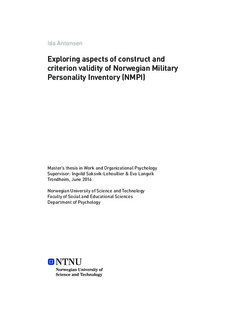Exploring aspects of construct and criterion validity Norwegian Military Personality Inventory (NMPI)
Master thesis
Permanent lenke
http://hdl.handle.net/11250/2450077Utgivelsesdato
2017Metadata
Vis full innførselSamlinger
- Institutt for psykologi [3140]
Sammendrag
Every instrument used for selection purposes should be valid, reliable and practical. The aim of this study is to examine the construct and criterion validity of Norwegian Military Personality Inventory (NMPI), a personality test developed by the Norwegian Armed Forces (NAF). During the summer of 2016, 715 candidates attending the NAFs assessment center answered a questionnaire containing NMPI and NEO Personality Inventory. As a part of a larger research project, this study seeks to bring more insight to the psychometric properties of NMPI. Construct validity was analyzed by comparing the NMPI to NEO-PI, and criterion validity was examined by studying the relationship between the five personality factors from NMPI and objective measures of performance during the assessment center. These performance criteria were competence scores from interview and field, and the dichotomous granted admission after the assessment center. The author found support for the premise that the NMPI does measure the Big Five factors of personality. Findings were: 1. Extraversion and Conscientiousness (both NMPI) positively predicted admission. 2. Openness to Experience (NMPI) negatively predicted performance in both field and interview. 3. Extraversion (NMPI) predicted better performance in the both field and interview. However, the amount of variance explained by the factors were 7% or lower in the respective regression analyses. Further, the data appears to have suffered from restricted variation. The results are discussed in terms of the existing literature and implications for future use of the inventory, as well as future research are suggested.
